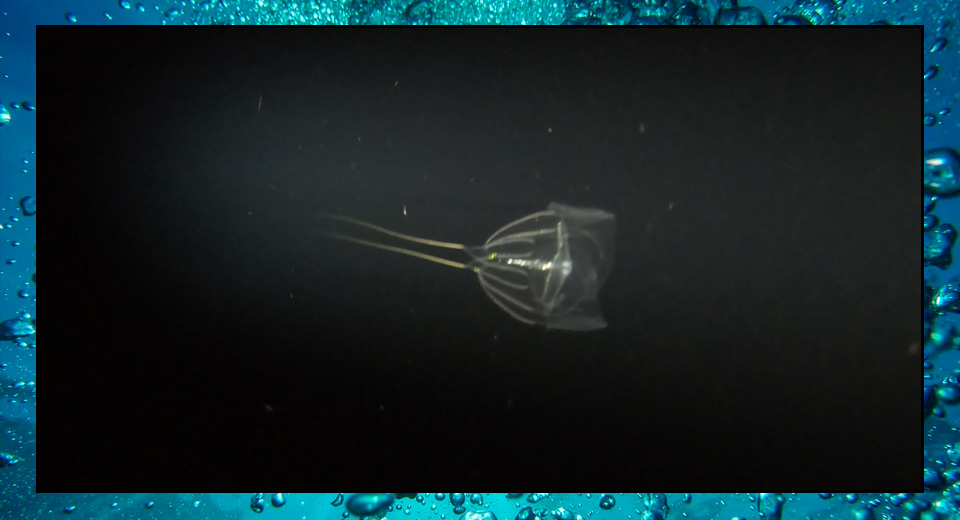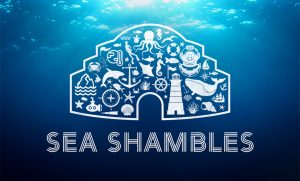Zooplankton Migration by Dr Helen Czerski
Sea Shambles Advent Calendar - Day 17December 17th
At night, a much-ignored population of ocean mini-beasties comes out to play.

This picture is a screenshot from video I took during a scuba dive earlier this year. I’ve dived in many parts of the ocean over the years, both for science and for fun, but this particular dive was one of the weirdest and most fascinating of them all. It plonked me right in the middle of a massive ocean event that I’ve talked about for years but never seen.
I like to ponder the challenges faced by creatures in the ocean, the ones that have been solved by trial and error over many generations during the process of evolution. Imagine being a small creature living in a vast pot of dense liquid. If you’re small, that liquid (salt water, just in case you were wondering), acts as though it’s pretty viscous and sticky. You can’t travel far and you can’t travel without effort. The ultimate source of energy in the system is sunlight from above, but you don’t have the biochemical machinery to use it. It’s like being surrounded by cans of food but not having a tin-opener. So you have to filch energy from the cooks of the ocean – the phytoplankton. They’ve got the tools to convert the sun’s energy and basic raw materials into sugars and proteins and all the other goodies that life needs. You are forced to become a hunter, and the phytoplankton are your prey. But your sticky watery world is full of other creatures who are facing the same problem, and they’re not going to bother with the phytoplankton – they see you as a much bigger and more valuable collection of protein and sugar and fats, all conveniently parcelled up and labelled “lunch”. They hunt by sight, and if they can see you, you’re toast.
So here’s the problem. Your food is up in the sunlight, because that’s where your prey – the little mini sunlight factories – work. But if you go up into the sunlight, you become dinner for something far bigger than you. What to do?
The animals who have to solve this problem are the zooplankton, which is a single name for an astonishingly broad range of small ocean animals. Some are only a single cell, some are tiny shrimp-like things, some are juvenile fish, some are marine snails, some are jellyfish, and some are even more weird and wonderful beasties. The zooplankton show off the fabulous variety of possible ocean lifestyles (I’ve said it before and I’ll say it again: if you want alien life, don’t go waiting to visit an exoplanet – just look in the ocean). But most of them face the same problem: the food is up above and the safety of darkness is down below.
The Cosmic Shambles Network relies on your support on pledges via Patreon so we can continue to provide great, new, exciting content without the need for third party ads or paywalls.
For as little as $1 a month you can support what we do and get some great rewards for doing so as well. Click the Patreon logo to pledge or find out more.
The solution reached by many of these creatures is the same: hide in the ocean depths during daytime and come up to the surface at dusk, when you can’t be seen. As it gets dark, all around the global ocean, a wave of tiny creatures paddles its legs, billows its bell-shaped canopy, puffs itself along and scoots up towards the surface. And this was what my dive put me into. I was attached to a vertical guide rope at a depth of about 20 metres in the pitch blackness of the Pacific ocean at night. Around me, the zooplankton were coming up to play. Wherever I shone my torch, fragments of life were whizzing and whirling, propelling themselves through the darkness in search of food. All of them looked impossibly fragile – ribbons and cylinders perhaps 10cm centimetres with long flashing mini fairy lights, chains of perfectly matching blobs, mini-jellyfish, small whooshing things that reminded me of fireworks. I floated in the middle of all this for 80 minutes, as long as the dive boat would let me, and watched the carnival go by.
This vertical migration of zooplankton happens every day in the ocean, all around the world. By biomass, it’s the biggest migration anywhere in the animal kingdom. But as the planet turns and the sunlight touches the water again, the zooplankton sink back into the depths, hidden from prying humans. To see them in person was an enormous privilege, like being let into a biological Aladdin’s cave. And now, when I see satellite pictures of darkness sweeping over the ocean, I imagine the vast swathes of zooplankton floating upwards in the darkness, visiting the surface to forage. A bug’s life in the ocean is a good one.
See what lies behind all the windows of the Sea Shambles Advent here.
 Sea Shambles is a one night only live extravaganza celebrating the oceans. Hosted by Robin Ince and Helen Czerski with Steve Backshall, British Sea Power, Josie Long, Lemn Sissay and more it’s a night of science, comedy, music, lasers and more in which we’ll be turning the Royal Albert Hall into an underwater playground the likes of which you’ve never seen! May 17 2020. Tickets start at just £10! Book here.
Sea Shambles is a one night only live extravaganza celebrating the oceans. Hosted by Robin Ince and Helen Czerski with Steve Backshall, British Sea Power, Josie Long, Lemn Sissay and more it’s a night of science, comedy, music, lasers and more in which we’ll be turning the Royal Albert Hall into an underwater playground the likes of which you’ve never seen! May 17 2020. Tickets start at just £10! Book here.
 Dr Helen Czerski is a physicist, first and foremost, but she’s acquired a few other labels along the way: oceanographer, presenter, author and bubble enthusiast. A regular on The Cosmic Shambles Network, she has also presented a number of acclaimed documentaries for the BBC and Fully Charged. Recently she was awarded the prestigious William Thomson, Lord Kelvin Medal and Prize from the Institute of Physics.
Dr Helen Czerski is a physicist, first and foremost, but she’s acquired a few other labels along the way: oceanographer, presenter, author and bubble enthusiast. A regular on The Cosmic Shambles Network, she has also presented a number of acclaimed documentaries for the BBC and Fully Charged. Recently she was awarded the prestigious William Thomson, Lord Kelvin Medal and Prize from the Institute of Physics.
If you would like to reuse this content please contact us for details
Subscribe to The Cosmic Shambles Network Mailing list here.
The Cosmic Shambles Network relies on your support on pledges via Patreon so we can continue to provide great, new, exciting content without the need for third party ads or paywalls.
For as little as $1 a month you can support what we do and get some great rewards for doing so as well. Click the Patreon logo to pledge or find out more.

